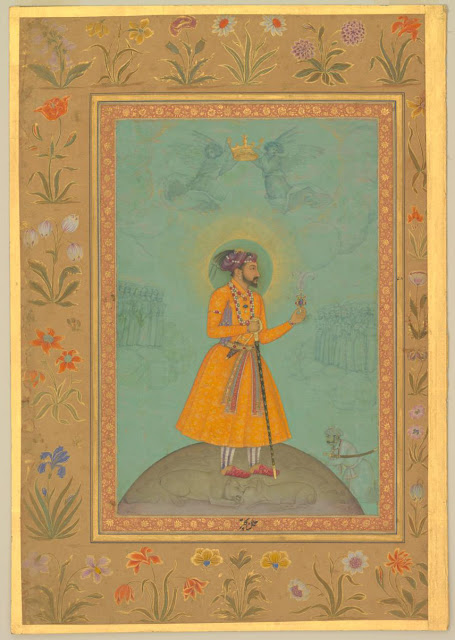 |
| Bichitr, Jujhar Singh Bundela Kneels in Submission to Shah Jahan, ca. 1630-40. Image (c) Trustees of he Chester Beatty Library, Dublin |
Rembrandt created 23 known ink drawings after Mughal Indian miniature paintings. They are a mystery of Rembrandt scholarship, for no one quite knows why he made them. All but three of the drawings have been brought to Los Angeles for the Getty Museum's "Rembrandt and the Inspiration of India." The exhibition juxtaposes the Dutch artist's drawings with prismatically colorful Mughal miniatures that were either his direct models or close facsimiles. In the Mughal empire, as in Holland, the "Golden Age" meant duplicating art for gold.
 |
| Rembrandt, Shah Jahan and Darah Shikoh, ca. 1656-61. The J. Paul Getty Museum, Los Angeles |
 |
| Govardhan, Shah Jahan Enthroned with His Son Dara Shikoh, 1630s. The San Diego Museum of Art, Edwin Binney 3rd Collection |
Until recently Rembrandt's Indian drawings were deprecated as outliers. Now they're prized as documents of the hybrid messiness of art history. "Rembrandt and the Inspiration of India" exemplifies a new interest in global interconnections. It shows that Mughal artists copied Dutch art as well as vice-versa.
One Rembrandt etching has been connected to a Mughal miniature of
Four Mullahs (that, speaking of hybrid, was later incorporated, Hearst Castle-like, into a Vienna palace's wall decoration). Rembrandt copies the miniature in ink, with the drawing known as
Four Mughal Elders Seated Under a Tree. The tree was originally in the miniature but was painted out in Vienna.
This Rembrandt drawing, in turn, must have informed the Old Testament figures of the artist's 1656 etching of
Abraham Entertaining the Three Angels. The print's date, which is also the year of Rembrandt's bankruptcy, is used to guesstimate that the Mughal drawings are c. 1656-1661. Rembrandt was by then a mature artist in his early 50s.
The most plausible theory is that Rembrandt made the Mughal drawings for his private instruction and enjoyment. Middle-aged and broke, he figured he still had a lot to learn.
 |
| Attributed to Bichitr, Akbar and Jahangir in Apotheosis, c. 1640. Private collection |







Comments